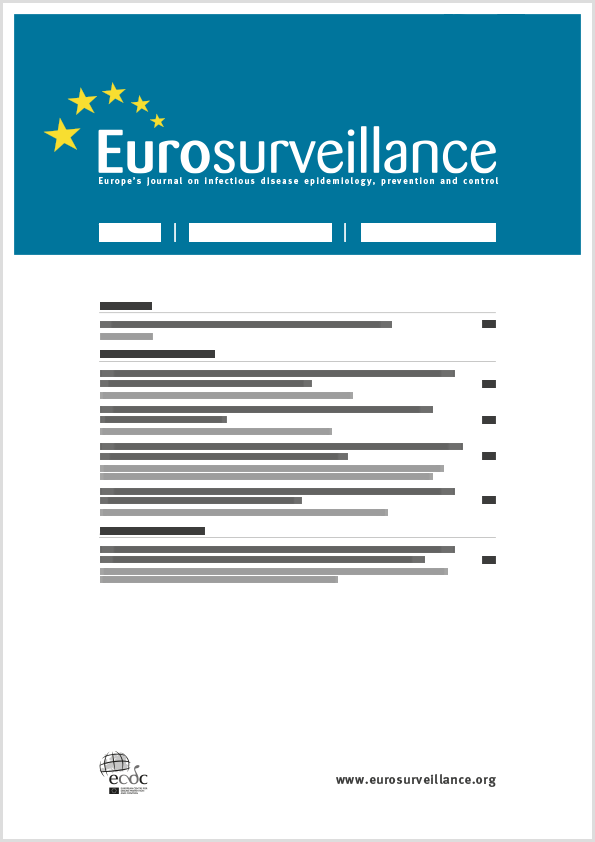- Home
- Eurosurveillance
- Previous Issues
- Volume 30, Issue 17, 01/May/2025
Eurosurveillance - Volume 30, Issue 17, 01 May 2025
Volume 30, Issue 17, 2025
- Outbreaks
-
-
-
A multi-country outbreak of Salmonella Mbandaka linked to pre-cooked, frozen chicken meat in ready-to-eat products, Finland, 2022 to 2023
More LessIn May 2022, the Finnish Institute for Health and Welfare observed an increase in Salmonella Mbandaka cases. Whole genome sequencing (WGS) linked the outbreak strain to a previously reported strain in the United Kingdom. From April 2022 to January 2023, 97 cases were reported across 18 of Finland’s 21 hospital districts, with a median age of 27 years (range <1–74 years) and 61% female cases. Based on trawling interviews and national food consumption data, cases were more likely to have eaten at a restaurant or takeaway (odds ratio (OR) = 115; 95% confidence interval (CI): 52–256; p < 0.001) or consumed poultry products (OR = 28; 95% CI: 7–115; p < 0.001). A case–case study linked cases with consumption of ready-to-eat products containing chicken from a specific company (OR = 28; 95% CI: 1.9–1,361; p = 0.004). Traceback investigations identified a pre-cooked, frozen chicken meat product from a country outside the European Union as the likely source. Salmonella Mbandaka was isolated from cases and linked by WGS to this chicken meat product. Our findings highlight the potential health risk of pre-cooked chicken meat containing Salmonella and the value of case–case studies and product images to assist recall during food-borne outbreak investigations.
-
- Top
-
- Surveillance
-
-
-
Incidence, case-fatality rates and risk factors of bloodstream infections caused by Escherichia coli, Klebsiella species and Pseudomonas aeruginosa, England, April 2017 to March 2022
More LessBackgroundEscherichia coli, Klebsiella spp. and Pseudomonas aeruginosa are included in the mandatory surveillance of bloodstream infections (BSI) in England.
AimWe aimed to investigate the epidemiology of these BSIs in England April 2017–March 2022.
MethodsWe extracted data on E. coli, Klebsiella spp. and P. aeruginosa BSI, categorised BSIs as healthcare-associated (HA) or community-associated (CA) and linked to antimicrobial susceptibility and mortality data. We used multivariable logistic regression models to assess predictors of mortality.
ResultsThe incidence rate of E. coli BSI was 71.8 per 100,000 population (95% confidence interval (CI): 71.5–72.1), Klebsiella spp. 19.1 (95% CI: 18.9–19.3) and P. aeruginosa 7.6 (95% CI: 7.5–7.7). Most (65,467/104,957) BSI episodes were CA. Case-fatality rate was 14.8% (95% CI: 14.6–14.9) in E. coli, 20.0% (95% CI: 19.6–20.3) in Klebsiella spp. and 25.8% (95% CI: 25.2–26.4) in P. aeruginosa BSI. Urinary tract infection (UTI) was the most reported primary infection for E. coli (56,961/100,834), Klebsiella spp. (9,098/22,827) and P. aeruginosa (3,204/8,484) BSI. Insertion or manipulation of urinary catheters was reported for 26.4% (16,136/61,043) of E. coli, 41.6% (4,470 /10,734) of Klebsiella spp. and 49.0% (2,127/4,341) of P. aeruginosa BSI. The adjusted odds ratio (OR) of death among hospital-onset HA-BSI compared to CA-BSI was 2.0 (95% CI: 1.9–2.2) for E. coli, 2.1 (95% CI: 2.0–2.3) for Klebsiella spp. and 1.7 (95% CI: 1.5–2.0) for P. aeruginosa.
ConclusionsAppropriate management of UTIs and urinary catheterisation is essential for reduction of these BSIs.
-
- Top
-
- Erratum
-
Volumes & issues
-
Volume 30 (2025)
-
Volume 29 (2024)
-
Volume 28 (2023)
-
Volume 27 (2022)
-
Volume 26 (2021)
-
Volume 25 (2020)
-
Volume 24 (2019)
-
Volume 23 (2018)
-
Volume 22 (2017)
-
Volume 21 (2016)
-
Volume 20 (2015)
-
Volume 19 (2014)
-
Volume 18 (2013)
-
Volume 17 (2012)
-
Volume 16 (2011)
-
Volume 15 (2010)
-
Volume 14 (2009)
-
Volume 13 (2008)
-
Volume 12 (2007)
-
Volume 11 (2006)
-
Volume 10 (2005)
-
Volume 9 (2004)
-
Volume 8 (2003)
-
Volume 7 (2002)
-
Volume 6 (2001)
-
Volume 5 (2000)
-
Volume 4 (1999)
-
Volume 3 (1998)
-
Volume 2 (1997)
-
Volume 1 (1996)
-
Volume 0 (1995)
Most Read This Month

-
-
Detection of 2019 novel coronavirus (2019-nCoV) by real-time RT-PCR
Victor M Corman , Olfert Landt , Marco Kaiser , Richard Molenkamp , Adam Meijer , Daniel KW Chu , Tobias Bleicker , Sebastian Brünink , Julia Schneider , Marie Luisa Schmidt , Daphne GJC Mulders , Bart L Haagmans , Bas van der Veer , Sharon van den Brink , Lisa Wijsman , Gabriel Goderski , Jean-Louis Romette , Joanna Ellis , Maria Zambon , Malik Peiris , Herman Goossens , Chantal Reusken , Marion PG Koopmans and Christian Drosten
-
- More Less


